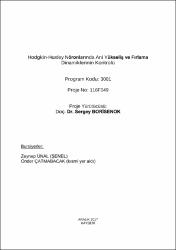| dc.contributor.author | Borisenok, Sergey | |
| dc.date.accessioned | 2024-03-18T13:08:32Z | |
| dc.date.available | 2024-03-18T13:08:32Z | |
| dc.date.issued | 2018 | en_US |
| dc.identifier.uri | https://hdl.handle.net/20.500.12573/2018 | |
| dc.description.abstract | Ani yükselen nöronları içeren ağlar, pek çok örüntü tanıma ve hesaplamalı nörobilim
uygulamalarında önemli bir rol oynamaktadır. Modern deneysel bilim, biyolojik nöronların
dinamiklerinin manipülasyonunda büyük bir ilerleme göstermektir. Fakat tek hücrenin ve
kollektif ani yükseliş ve fırlama ile ilgili doğrusal olmayan davranışlarının kontrolünün
matematiksel modellemesindeki teoretik algoritmaların geliştirilmesine ihtiyaç duymaktadır.
Projenin amacı, biyolojik nöronları modelleyen dört boyutlu dinamik sistemlerin ani yükseliş
ve fırlama dinamiklerini dizayn etmek için etkili matematiksel kontrol algoritmaları
geliştirmektir.
Bu amaç için, deneysel olarak en çok kabul edilen ve nöronların matematiksel modellemesi
için gerçekçi olan dört boyutlu Hodgkin-Huxley (HH) doğrusal olmayan dinamik sistemi
seçilmiştir. Membran aksiyon potansiyelleri sistem çıkışı olması rağmen, nöronal kümelerde
dolaşan elektrik akımları kontrol sinyali olarak hizmet etmektir. HH modelindeki ani yükseliş
rejimlerini tasarlamak ve sistemin dinamik davranışını üzerine yüklemek için, iki alternatif
kontrol metodu kullanılır: hız gradyanı (HG) ve hedef çekicisi (HÇ) geribeslemeli kontrol. Son
zamanlarda ispat ettiğimiz gibi, her iki metot dayankı-ve-yangın nöronların basitleştirilmiş iki
boyutlu modellerinde dinamik davranışlarını kontrol etmek için yüksek verimlilik ve
dayanıklılık göstermektedir.
Bu projede teorik kontrol algoritmasının HG ve HÇ iki farklı formu, Hodgkin-Huxley nöron
ağının aksiyon potansiyelini izlemek için tasarlanmıştır. Metot, tek nöron üzerinde aktif
kontrol uygulayarak, seçilmiş nöron kümesi düzeni (doğrusal ve halka şeklinde nöron zinciri)
için isteğe bağlı aniyükseliş (spike), ani yükseliş dizisi (spike train) ve fırlama (burst)
şekillerinin üretilmesine izin verir.
Projede geliştirilen algoritma küçük bir Hodgkin-Huxley nöron kümesi için epileptik yapıdaki
toplu fırlamaları baskılamak için kullanılmaktadır.
Böylece, proje biyolojik nöronların matematiksel modelleri için uygulanan kontrol teorisinde
uygun bir yer edinebilir ve Hodgkin - Huxley nöronal ağlarının temel küme yapılarındaki
isteğe bağlı ani yükseliş veya fırlama rejiminin etkin nesili için özgün bir algoritma
geliştirebilir. | en_US |
| dc.description.abstract | Networks with spiking neurons play an important role in many applications of pattern
recognition and computational neuroscience. Modern experimental science demonstrates a
great progress in manipulation with the dynamics of biological neurons but the mathematical
modeling for controlling nonlinear behavior of single cells and their collective spiking and
bursting still needs a sufficient improvement of theoretical algorithms.
The aim of the project is the development of efficient mathematical control algorithms to
design the spiking and bursting behavior in 4-dimensional dynamical systems modeling
biological neurons.
For this purpose, we chose 4-dimensional Hodgkin-Huxley’s (HH) nonlinear dynamical
system as the most experimentally approved and realistic for mathematical modeling of real
neurons. Electrical currents circulating in the neuronal clusters serve as control signals, while
the membrane action potentials are outputs. To design spiking regimes in the HH model and
impose it on the dynamical behavior of the system we use two alternative control methods:
speed gradient (SG) and target attractor (TA) feedbacks that demonstrate, as we proved
recently, high efficiency and robustness for controlling dynamical behavior in the simplified 2-
dymensional representations of resonate-and-fire neurons.
In this project the theoretical control algorithm in two alternative forms, SG and TA, is
designed to track the axon action potentials in the network of Hodgkin-Huxley neurons. This
method allows producing arbitrary shapes of single spikes, spike trains and bursts for
selected cells in the basic configuration of neuron clusters (linear chains and ring-type
chains) via the active control over only one chosen element of the population.
The algorithm developed in the project is also applied for suppression of epileptiform
collective bursting in a small cluster of Hodgkin-Huxley neurons.
Thus, the project aims to cover a sufficient luck in the applied control theory for
mathematical models of biological neurons and develop a novel algorithm for the efficient
generation of a desired spiking or bursting regimes in the basic cluster configurations of
Hodgkin-Huxley neuronal networks. | en_US |
| dc.language.iso | tur | en_US |
| dc.publisher | TUBİTAK | en_US |
| dc.rights | info:eu-repo/semantics/openAccess | en_US |
| dc.subject | Hodgkin-Huxley nöronu | en_US |
| dc.subject | hız gradyan metodu | en_US |
| dc.subject | hedef çekicisi geribeslemesi | en_US |
| dc.subject | Hodgkin-Huxley neuron | en_US |
| dc.subject | speed gradient method | en_US |
| dc.subject | target attractor feedback | en_US |
| dc.title | Hodgkin-Huxley Nöronlarında Ani Yükseliş ve Fırlama Dinamiklerinin Kontrolü | en_US |
| dc.type | project | en_US |
| dc.contributor.department | AGÜ, Mühendislik Fakültesi, Elektrik - Elektronik Mühendisliği Bölümü | en_US |
| dc.contributor.authorID | 0000-0002-1992-628X | en_US |
| dc.contributor.institutionauthor | Borisenok, Sergey | |
| dc.identifier.startpage | 1 | en_US |
| dc.identifier.endpage | 57 | en_US |
| dc.relation.journal | Tubitak | en_US |
| dc.relation.tubitak | 116F049 | |
| dc.relation.publicationcategory | Diğer | en_US |


















